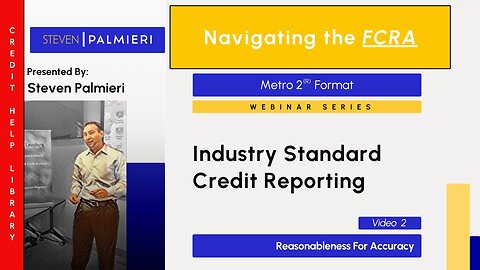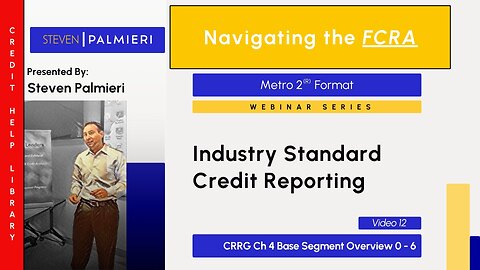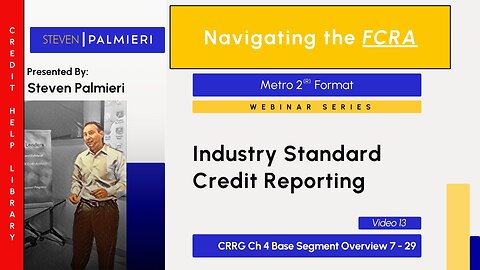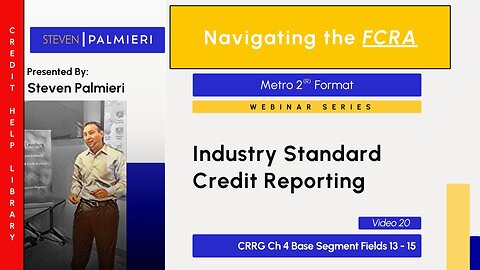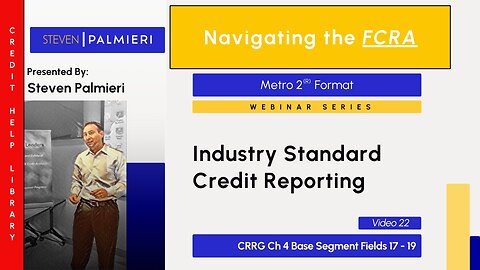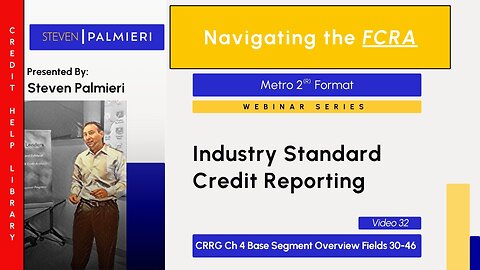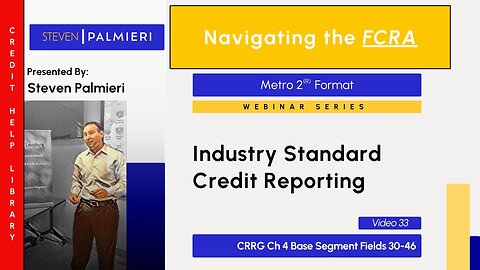Premium Only Content
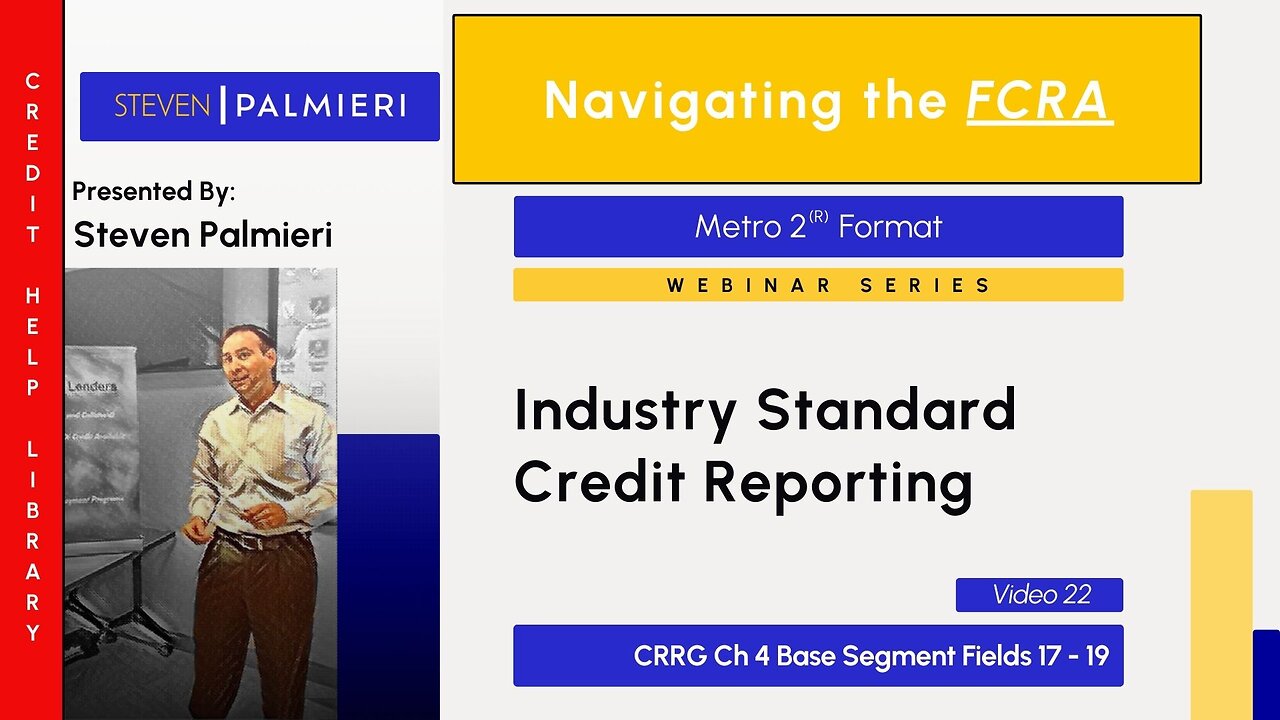
What is an Industry Standard
Reasonableness for Accuracy
Reasonableness for Dispute Procedures
Metro 2 Table of Contents
Ch 1 Overview
Ch 2 Overview
Ch 3 Overview
Ch 4 Overview
Ch 4 Segment Overview
Ch 4 Header Record Segment Overview
Ch 4 Base Segment Overview
Ch 4 Base Segment Overview Fields 0 - 6
Ch 4 Base Segment Overview Fields 7 - 29
Ch 4 Base Segment Field 7
Ch 4 Base Segment Field 8
Ch 4 Base Segment Field 9
Ch 4 Base Segment Field 10
Ch 4 Base Segment Field 11
Ch 4 Base Segment Field 12
Ch 4 Base Segment Fields 13 - 15
Ch 4 Base Segment Field 16
Ch 4 Base Segment Field 16
Ch 4 Base Segment Fields 17 - 19
Ch 4 Base Segment Field 20
Ch 4 Base Segment Field 21
Ch 4 Base Segment Field 22
Ch 4 Base Segment Field 23
Ch 4 Base Segment Field 24
Ch 4 Base Segment Field 25
Ch 4 Base Segment Field 26
Ch 4 Base Segment Field 27
Ch 4 Base Segment Field 28
Ch 4 Base Segment Overview 30 - 46
Ch 4 Base Segment Fields 30 - 46
Ch 4 J1 Segment Overview
Ch 4 J1 Segment Fields 1 - 12
Ch 4 J2 Segment Overview
Ch 4 J2 Segment Fields 1 - 11
Ch 4 J2 Segment Fields 12 - 20
Ch 4 K1 Segment Overview
Ch 4 K1 Segment Fields 1 - 3
Ch 4 K2 Segment Overview
Ch 4 K2 Segment Fields 1 - 4
Ch 4 K3 Segment Overview
Ch 4 K3 Segment Fields 1 - 4
Ch 4 K4 Segment Overview
Ch 4 K4 Segment Fields 1 - 6
Ch 4 L1 Segment Overview
Ch 4 L1 Segment Fields 1 - 5
Ch 4 N1 Segment Overview
Ch 4 N1 Segment Fields 1 - 9
Ch 4 Trailer Segment Overview
Ch 5 Overview
Ch 5 Exhibit 1 - 2
Ch 5 Exhibit 3
Ch 5 Exhibit 4
Ch 5 Exhibit 5
Ch 5 Exhibits 6 - 7
Ch 5 Exhibit 8
Ch 5 Exhibit 9
Ch 5 Exhibit 10
Ch 5 Exhibit 11
Ch 5 Exhibits 12 - 16
Ch 6 Overview
Ch 7 Overview
Ch 8 Overview
Ch 9 - 13 Summary
Ch 9 Overview
Ch 10 Overview
Ch 11 Overview
Ch 12 Overview
Ch 13 Overview
Ch 14 Overview
Ch 4 Base Segment Fields 17 - 19
The video explores Base Segment Fields #17A, #17B, #18, and #19 from Chapter 4 of the Metro 2 Credit Reporting Resource Guide, showing readers how to use Metro 2 to accurately read credit reports, identify errors, and draft dispute letters to consumer reporting agencies (CRAs). These fields—account status (#17A), payment rating (#17B), payment history profile (#18), and special comment code (#19)—interrelate to describe an account’s condition, using a paid, closed credit card with zero balance as an example.
Field #17A (account status) uses codes from Exhibit 4 (Chapter 5), like code 13 for "paid or closed, zero balance," reflecting the account’s state as of the "date of account information" (e.g., 16th of last month). Field #17B (payment rating) is required for certain statuses (e.g., code 13), indicating the account’s condition—here, "current" (0-29 days past due)—before reaching its final status within the current reporting month. Field #18 (payment history) covers the prior 24 months up to the last period (e.g., two months ago), showing consistent on-time payments (code 0), as current-month status is handled by #17A and #17B. Metro 2 mandates monthly reporting, but allows a "B" fill (no history) if data is unavailable—though this may not meet "maximum possible accuracy." Field #19 (special comment) adds detail via Exhibit 6/7 codes, like "M" for "closed at credit grantor’s request."
These fields clarify how a report should align: #17A shows the final status, #17B the prior state in the same month, #18 the historical record, and #19 any special notes. Errors—like missing history, inconsistent statuses (e.g., "paid" with a "collection" rating), or absent special comments—can be disputed by comparing to Metro 2’s rules, providing solid grounds for letters to CRAs.
-
 20:22
20:22
Real Estate
8 days ago $5.56 earnedNumber 1 Indicator Home Prices ARE ABOUT TO CRASH
9.64K4 -
 30:09
30:09
Afshin Rattansi's Going Underground
18 hours ago‘Gaza Will Haunt Israel for Generations’- Mika Almog Granddaughter of Former President Shimon Peres
10.7K7 -
 15:36
15:36
Nikko Ortiz
14 hours agoBring Back Public Shaming...
13.7K7 -
 2:43:41
2:43:41
Side Scrollers Podcast
20 hours agoAsmongold Says The Online Left Are “ANIMALS” + Hasan Collar-Gate Gets WORSE + More | Side Scrollers
20.9K17 -
 1:33:41
1:33:41
Dinesh D'Souza
2 days agoThe Dragon's Prophecy Film
89.7K58 -
 LIVE
LIVE
Lofi Girl
2 years agoSynthwave Radio 🌌 - beats to chill/game to
339 watching -
 44:08
44:08
The Why Files
6 days agoThe CIA, Men in Black and the Plot to Take Out JFK | The Maury Island Incident
53.7K67 -
 2:07:23
2:07:23
TimcastIRL
11 hours agoTrump SLAMS China With NEW 100% Tariff, Stocks & Crypto TUMBLE | Timcast IRL
302K162 -
 5:15:25
5:15:25
SpartakusLIVE
11 hours agoBF6 LAUNCH DAY || WZ and BF6 followed by PUBG - The PERFECT Combo?
66.1K3 -
 1:33:59
1:33:59
Glenn Greenwald
13 hours agoQ&A with Glenn: Is the Gaza Peace Deal Real? Why was the Nobel Peace Prize Given to Venezuela's Opposition Leader? And More... | SYSTEM UPDATE #529
121K73

